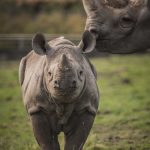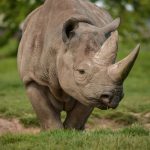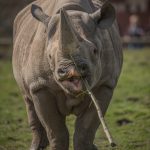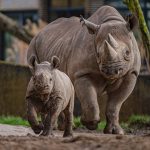Partners and collaborators
securing a future for the Black Rhino
Our work with the black rhino is a perfect example of our ‘One Plan’ and highly collaborative approach to conservation science. Our team of keepers and scientists work with scholars and practitioners around the world, to protect both in zoo and wild populations.
Chester Zoo holds the ‘stud book’ as part of the EAZA Ex-Situ Programmes (EEP), with the aim of conserving healthy populations of animals in zoos and the regular exchange of animals between and beyond EAZA Members, in order to enable healthy, demographically and genetically sustainable populations to thrive.
conservation physiology toolbox
The reproduction rates of the critically endangered black rhino had been declining for some time, so we worked alongside a number of other zoos and the Kenyan Wildlife Service, to unlock the solutions that would reverse this decline.
Our ‘conservation physiology toolbox’, the culmination of a five year research project led by Katie Edwards and supported by our own keepers and scholars, concluded that the reproductive success of females could be determined by 3 main factors; abnormal ovarian cycles, high body condition scores (overweight) and those with a more sensitive temperament – therefore more reactive to stress.
Our animal care teams were able to adapt animal management processes and use the data from the lab, to provide the right conditions for reproductive success. Over time, we saw the impact of these changes with 10 rhino calves born at Chester Zoo between 2008 and 2018.
The work in zoos resulted in the founding of a lab, Lewa Wildlife Conservancy Kenya, where vet Matthew Matinda from the Kenyan Wildlife Service is working with Chester Zoo scholars to consider how our work can be applied with wild populations, and how our ‘conservation physiology toolbox’ can be extended to develop biomarkers related to other health and wellbeing factors. We hope that this work will also help us to further understand the genetics of wild populations in the future.
Finding safe places to thirve
Our work to protect populations and understand the key factors that impact survival and reproduction, is reinforced through our commitment to finding safe places for rhinos to thrive. EEP members are keen to ensure that where appropriate, we can reintroduce our animals to the wild in order to provide genetic viability to the wild population. We strive to use scientific research to establish how best to reintroduce animals to the wild, successfully.
And finally, we passionately believe in empowering people to protect rhinos in the wild, and have worked for a number of years with our partners, Big Life Foundation in Kenya, to help achieve this. We help fund their rangers who protect rhinos from poaching, and support a range of school and community outreach projects, such as the Massai Olympics, to help reduce human wildlife conflict and the risk of poaching.
By working together, we can help prevent the extinction of the black rhino.
NOW is the time to ACT FOR WILDLIFE. Conservation is CRITICAL; species are under threat. TOGETHER we can make a BIG difference. Take action TODAY and join us in PREVENTING EXTINCTION.












